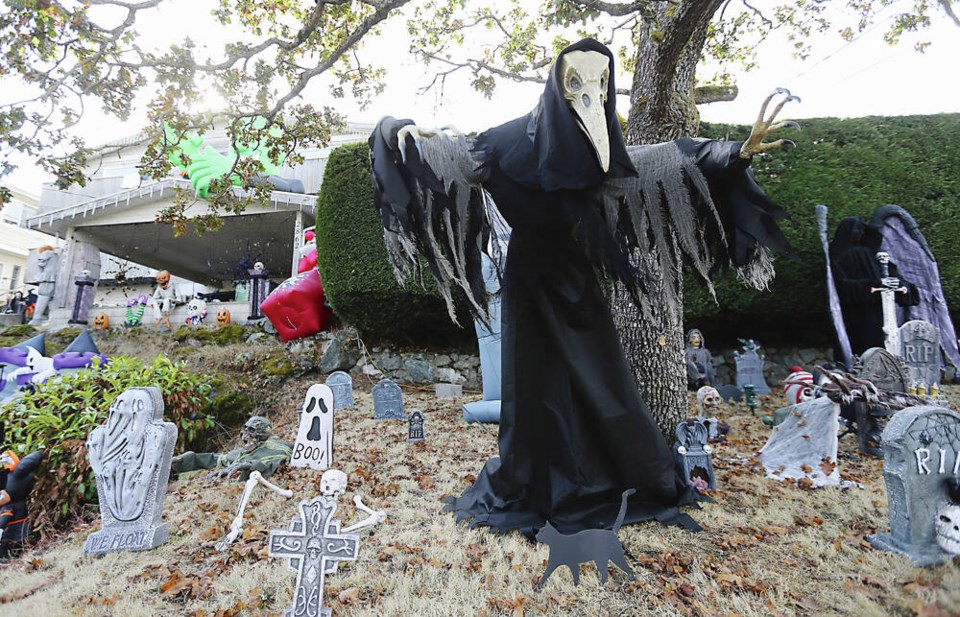It’s late October and you have a lot of leaf-raking/beer-drinking this weekend so I’ll get right to the point: Halloween is a North American holiday with a past in ancient Europe and a future in hyperglycemic health emergency.
Insert scary noise here: Wooooo-oooooo-ooooh!
Originally, Halloween was a Celtic celebration to mark the boundary between the light and dark halves of the Force or the seasons or something, which also included the boundary between the living and dead because why not? People will believe anything, anytime.
According to the 91原创 Encyclopedia, North America’s first recorded instance of dressing in disguise on Halloween was in 91原创, in 1898, while the first recorded use of the term “trick or treat” was in Lethbridge, Alberta, in 1927. So all this Halloween business is pretty recent, and needs a closer look.
Trick-or-treating
Nobody really knows how or why modern trick-or-treating began, but there are three main theories. The first suggests it came from the Celts, who left food out to appease spirits travelling the earth during Samhain (pronounced “SAW-wane” because everything spooky wants to have a kooky spelling that looks more cool, like “magick” and “foooolish”).
The Celts were pagans who worried quite a bit about these spirits, which were always in need of appeasement, sort of like Quebec. Eventually, people began to dress like the spirits, at least the ones that looked like hobos, Dracula and slutty nurses.
The second theory lays the blame solely on the Scots, due to that people’s practice of “guising,” which is the secular version of “souling,” in which children and other poor people in the medieval age prayed for the souls of rich people in exchange for food.
I swear I’m not making this up. Guising replaces prayers with non-religious Scottish activities such as heavy drinking, fighting, and toilet-papering trees, but the food reward part stays the same.
That brings us to the third, and most likely, theory: fat Americans. More specifically, fat German-Americans whose holiday traditions included “belsnickeling,” where children dressed in costume to fool neighbourhood adults as to the identity of the Boston Strangler.
Wait, no… checking my notes… Ah, I see the children were rewarded with treats if no one could identify them, thus leading to the twin pillars of American culture: mistrusting authority and type 2 diabetes.
Black cats
Although racist, the idea of being spooked by black cats comes from the Middle Ages, when these dark felines were considered a symbol of the devil. Of course, today in the modern era of science we know that ALL cats are symbols of the devil and should be avoided, unless you are what medical science calls a “crazy cat lady.” Over time, people came to believe that crazy cat ladies (of both genders) were witches because they probably were, and cats were the witches’ “familiar” — a supernatural entity that assists with all dark magic practices not requiring opposable thumbs.
Orange and black
I know you’re wondering about the Halloween colour scheme: What’s with orange and black? This is another gift from the Celts, which I should mention included the people of Wales, if that helps explain things. Black meant the death of summer to the Celts, and orange symbolized both the autumn harvest and the Cincinnati Bengals, even though they have yet to win a Super Bowl.
Bats
Bats have been part of Halloween since Adam was a lad, not just symbolically but literally. During Samhain, the Celts lit towering bonfires to light the way for souls seeking to increase greenhouse gases in the afterlife. Anyway, the bonfires attracted insects, which in turn attracted bats. It didn’t take long for the Celts to notice that bats are pretty creepy-looking up close, and medieval folklore expanded that eeriness with superstitions that bats were harbingers of death.
How silly! Also, does anyone remember COVID-19?
Carved Pumpkins
The name Jack-o’-Lantern comes from the 17th century Irish myth of Stingy Jack. According to Irish folklore, Stingy Jack was a drunkard and a cheat who was refused entry into both heaven (obvs) and hell (because he played tricks on the devil in another part of the Marvel Multiverse).
Anyway, Stingy Jack was condemned to roam the half-world between the living and the dead until Judgment Day with only an ember from hell to light his way, kept in a carved-out turnip as a lantern. Thus he became known as Jack of the lantern, or Jack-o’-Lantern, the bane of Mount Douglas Parkway in early November.
Excessive candy
Bloomberg reports that 91原创s will spend a total of $1.64 billion on Halloween this year, making it the second-most commercially successful holiday, behind Christmas. That’s 28 per cent more than last year (but $730 million less than before the pandemic in 2019).
On average, 91原创s are expected to spend $87.60 on Halloween: $41.50 on a costume, $22.40 on candy, $12.90 on activities, and $10.80 on pumpkins and other decorations. Every man, woman and child in the nation spending $22.40 on candy seems like a lot of candy to me. Especially since candy was not really part of Halloween until the mid-20th century. Before then, “treats” handed out at the door included things like fruit and nuts. You know, garbage.
This presented a major opportunity for candy companies, who created small, individually wrapped treats that would not get fuzzy in the bottom of mom’s purse. Halloween candy really took off in the 1970s when parents started fearing anything unwrapped that might contain razor blades, bats or the Cincinnati Bengals.
That brings us to Halloween today. I live in a house at the top of a big hill, and we don’t get a lot of trick-or-treaters. That $22.40 of candy is mine, all mine — the spirits can bugger off to Scotland. Wooooo-oooooo-ooooh!
>>> To comment on this article, write a letter to the editor: [email protected]



